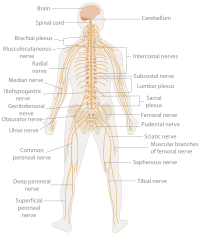
Photo from wikipedia
Asymmetric substitution of end‐groups is first applied in molecular donors. Three commonly used end‐groups of 2‐ethylhexyl cyanoacetate (CA), 2‐ethylhexyl rhodanine (Reh), and 1H‐indene‐1,3(2H)‐dione (ID) are combined to construct a series… Click to show full abstract
Asymmetric substitution of end‐groups is first applied in molecular donors. Three commonly used end‐groups of 2‐ethylhexyl cyanoacetate (CA), 2‐ethylhexyl rhodanine (Reh), and 1H‐indene‐1,3(2H)‐dione (ID) are combined to construct a series of symmetric and asymmetric donors. Correspondingly, the asymmetric donors SM‐CA‐Reh and SM‐CA‐ID show largely increased dipole moments (2.14 and 3.39 D, respectively) and enhanced aggregation propensity, as compared to those of symmetric donors of SM‐CA, SM‐Reh, and SM‐ID. Using N3 as acceptor, interestingly, SM‐CA‐Reh integrates the photovoltaic characteristics of high fill factor (FF) for SM‐CA and high short‐circuit current density for SM‐Reh, and delivers a record power conversion efficiency (PCE) of 16.34% with a high FF of 77.5%, which is much higher than 15.41% for SM‐CA and 14.76% for SM‐Reh. However, SM‐CA‐ID and SM‐ID give the lower PCE of 8.20% and 2.76%. Characterization results suggest that the π–π interaction mainly dictates the packing morphology of blend films instead of dipole effect or crystallinity. Mono‐substitution of Reh facilitates the molecular demixing appropriately but keeps the characteristic of the fine bicontinuous network of SM‐CA:N3. SM‐CA‐Reh:N3 shows more efficient exciton extraction, higher hole transport, and better miscibility. These results well explain the merits integration and improved photovoltaic performance.
Journal Title: Advanced Materials
Year Published: 2022
Link to full text (if available)
Share on Social Media: Sign Up to like & get
recommendations!